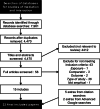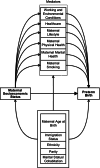Mediators of socioeconomic inequalities in preterm birth: a systematic review
- PMID: 35668387
- PMCID: PMC9172189
- DOI: 10.1186/s12889-022-13438-9
Mediators of socioeconomic inequalities in preterm birth: a systematic review
Abstract
Background: Rates of preterm birth are substantial with significant inequalities. Understanding the role of risk factors on the pathway from maternal socioeconomic status (SES) to preterm birth can help inform interventions and policy. This study therefore aimed to identify mediators of the relationship between maternal SES and preterm birth, assess the strength of evidence, and evaluate the quality of methods used to assess mediation.
Methods: Using Scopus, Medline OVID, "Medline In Process & Other Non-Indexed Citation", PsycINFO, and Social Science Citation Index (via Web of Science), search terms combined variations on mediation, socioeconomic status, and preterm birth. Citation and advanced Google searches supplemented this. Inclusion criteria guided screening and selection of observational studies Jan-2000 to July-2020. The metric extracted was the proportion of socioeconomic inequality in preterm birth explained by each mediator (e.g. 'proportion eliminated'). Included studies were narratively synthesised.
Results: Of 22 studies included, over one-half used cohort design. Most studies had potential measurement bias for mediators, and only two studies fully adjusted for key confounders. Eighteen studies found significant socioeconomic inequalities in preterm birth. Studies assessed six groups of potential mediators: maternal smoking; maternal mental health; maternal physical health (including body mass index (BMI)); maternal lifestyle (including alcohol consumption); healthcare; and working and environmental conditions. There was high confidence of smoking during pregnancy (most frequently examined mediator) and maternal physical health mediating inequalities in preterm birth. Significant residual inequalities frequently remained. Difference-of-coefficients between models was the most common mediation analysis approach, only six studies assessed exposure-mediator interaction, and only two considered causal assumptions.
Conclusions: The substantial socioeconomic inequalities in preterm birth are only partly explained by six groups of mediators that have been studied, particularly maternal smoking in pregnancy. There is, however, a large residual direct effect of SES evident in most studies. Despite the mediation analysis approaches used limiting our ability to make causal inference, these findings highlight potential ways of intervening to reduce such inequalities. A focus on modifiable socioeconomic determinants, such as reducing poverty and educational inequality, is probably necessary to address inequalities in preterm birth, alongside action on mediating pathways.
Keywords: Causal inference; Maternal smoking; Mediation; Preterm birth; Socioeconomic inequalities.
© 2022. The Author(s).
Conflict of interest statement
The authors declare that they have no competing interests.
Figures



References
-
- Blumenshine P, Egerter S, Barclay CJ, Cubbin C, Braveman PA. Socioeconomic disparities in adverse birth outcomes: a systematic review. Am J Prev Med. 2010;39(3):263–72. - PubMed
-
- Ruiz M, Goldblatt P, Morrison J, Kukla L, Švancara J, Riitta-Järvelin M, et al. Mother’s education and the risk of preterm and small for gestational age birth: a DRIVERS meta-analysis of 12 European cohorts. J Epidemiol Community Health. 2015;69(9):826. doi: 10.1136/jech-2014-205387. - DOI - PMC - PubMed
Publication types
MeSH terms
Grants and funding
LinkOut - more resources
Full Text Sources

